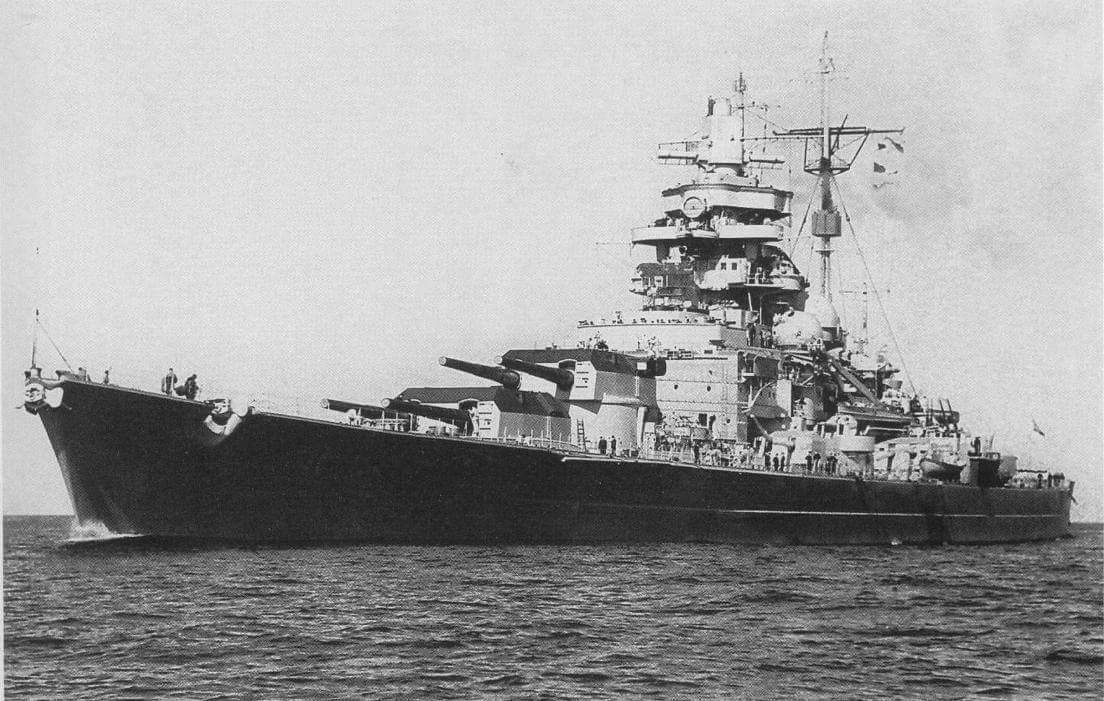In an early post, we briefly touched upon high velocity, shallow arc and lower velocity, higher arc guns.
While discussions on muzzle velocity are typically examined from a range, accuracy, or penetration angle, one other factor existed that played an equal if not larger role.
While discussions on muzzle velocity are typically examined from a range, accuracy, or penetration angle, one other factor existed that played an equal if not larger role.

This factor is barrel wear. Something that influenced naval design for several navies.
The forces required to force a heavy naval shell through a barrel are tremendous. The intense heat and pressure places a great deal of strain on the barrel
The forces required to force a heavy naval shell through a barrel are tremendous. The intense heat and pressure places a great deal of strain on the barrel

Each shell that is forced down the barrel strips a tiny bit of the barrel along with it. This damage is typically towards the breech of the gun, concentrated towards the start of the rifling. However, successive shots allow the damage to extend further down the barrel.. 

Eventually, the wear extends throughout the entire barrel.
Barrel wear can severely impact the performance of the gun. As the barrel wears away, the shell is not properly sealed inside. Gasses from the propellants can leak around the shell, reducing velocity.
Barrel wear can severely impact the performance of the gun. As the barrel wears away, the shell is not properly sealed inside. Gasses from the propellants can leak around the shell, reducing velocity.

As velocity decreased, it led to a further decrease in penetration power and accuracy.
Barrel wear, and its impact on performance, became a major factor for several navies and influenced how they began developing their naval guns.
Barrel wear, and its impact on performance, became a major factor for several navies and influenced how they began developing their naval guns.

For the Royal Navy and the United States Navy, their battleships would typically be deployed far away from their shores.
Operating across the globe, the ships did not have easy access to ports that had the equipment capable of handling the process of replacing gun barrels.
Operating across the globe, the ships did not have easy access to ports that had the equipment capable of handling the process of replacing gun barrels.

During times of war, it was also an issue to have warships out of service to have barrels replaced, reducing effective units at sea.
This issue was further compounded by the fact that even ships outside of combat were using their weapons for training and gunnery practice.
This issue was further compounded by the fact that even ships outside of combat were using their weapons for training and gunnery practice.

For the Royal and United States Navies, this was a key factor in the adoption of lower velocity guns. The lower muzzle velocities preserved barrel life, allowing the ships to fire more rounds before having the need to return to port for replacement and other repairs. 

Most of the typical guns of the US and UK navies enjoyed substantial barrel lives. For example, look at the following:
US 16" Mark 7 - 300-350 (2500fps)
US 16" Mark 6- 395 (2300fps)
US 16" Mark 4 - 350 (2,600fps)
UK 15" Mk 1 - 335 (2460fps)
UK 14" Mk 7 - 340 (2483fps)
US 16" Mark 7 - 300-350 (2500fps)
US 16" Mark 6- 395 (2300fps)
US 16" Mark 4 - 350 (2,600fps)
UK 15" Mk 1 - 335 (2460fps)
UK 14" Mk 7 - 340 (2483fps)

In contrast to the US and UK, several navies opted for higher muzzle velocity guns. These powerful guns provided for superior range and power at the cost of a shorter barrel life. Italy and Germany are two such navies that opted for higher muzzle velocities. 

Compared to the previous figures, look at the barrel lives for the heavy guns of the Germany and Italian battleships:
German 15" 190-210 (2700fps)
Italian 15" 110-130 (2850fps (Later reduced to 2790fps))
A substantial difference.
German 15" 190-210 (2700fps)
Italian 15" 110-130 (2850fps (Later reduced to 2790fps))
A substantial difference.

With that being said, the difference was not that important.
The US and UK had to accept a slight performance penalty to maximize barrel life. This allowed them to operate across the globe. Their battleships might partake in several engagements before the need to return to port
The US and UK had to accept a slight performance penalty to maximize barrel life. This allowed them to operate across the globe. Their battleships might partake in several engagements before the need to return to port

On the other hand, German and Italian battleships would always be relatively close to port. German ships might make brief forays into the Atlantic but would quickly return to port. Italian battleships would rarely, if at all, operate more than a day's journey from port. 

This allowed the German and Italian ships to sacrifice barrel life in favor of superior ballistics, a luxury that the US and UK could not afford.
It was a trade-off, one that was heavily influenced by the logistics of a navy as well as the intended theatre of operation.
It was a trade-off, one that was heavily influenced by the logistics of a navy as well as the intended theatre of operation.

Yet another lesson in the intricacy of battleship design and operation!
In another post, we will dig a bit deeper and look at the methods used to further preserve barrel life.
#History #wednesdaythought #tuesdayvibe #Navy #Military #WW2 #KnowyourMil
In another post, we will dig a bit deeper and look at the methods used to further preserve barrel life.
#History #wednesdaythought #tuesdayvibe #Navy #Military #WW2 #KnowyourMil

• • •
Missing some Tweet in this thread? You can try to
force a refresh






















